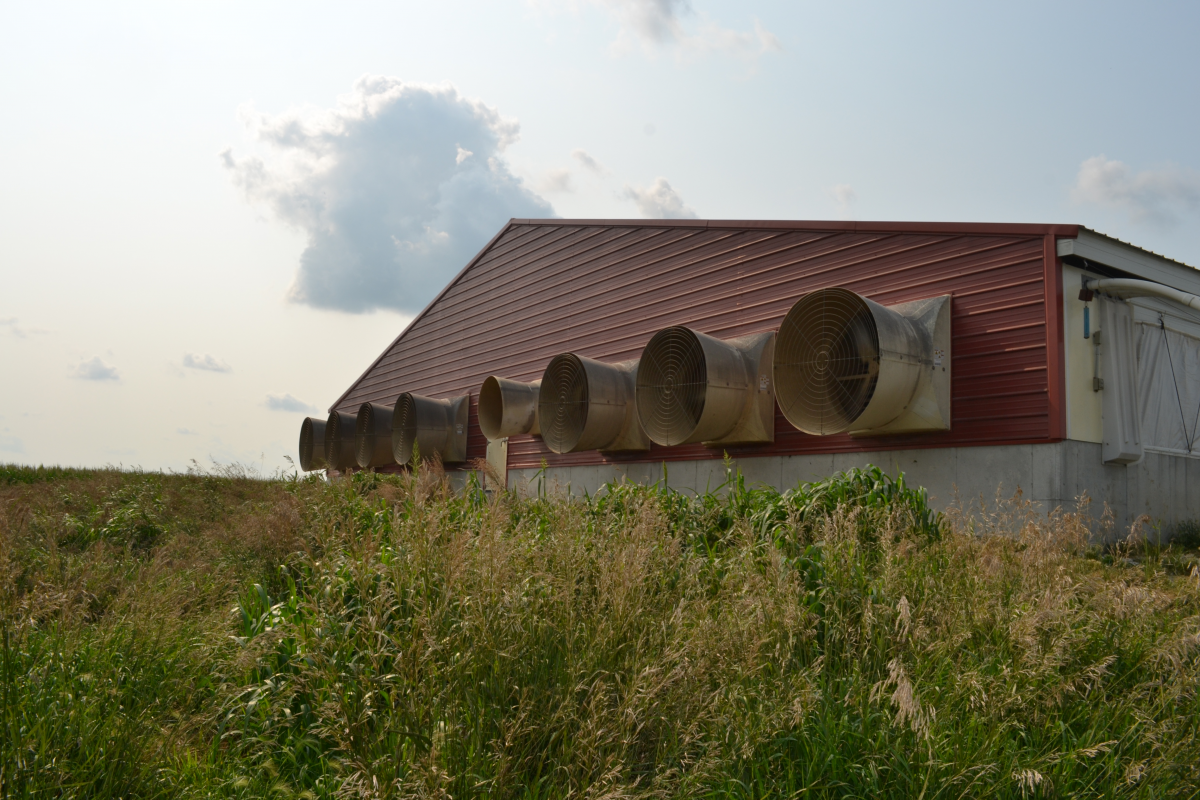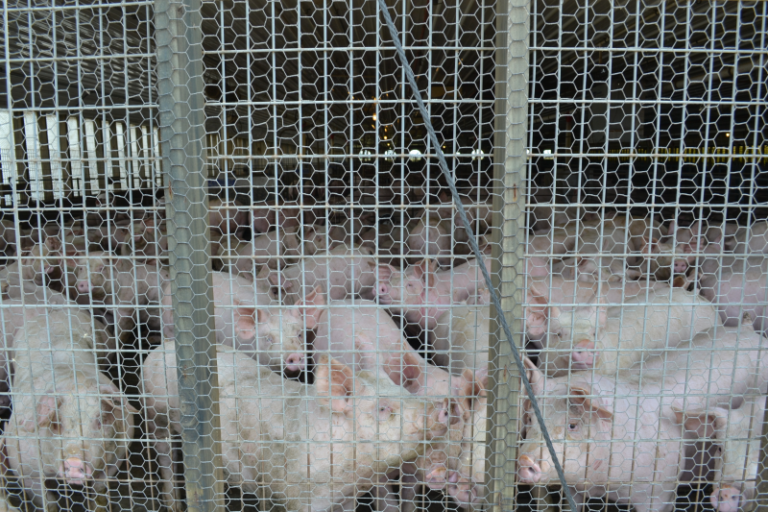RAYMOND — A pig’s ideal temperature is 65 degrees Fahrenheit.
So on a 90-degree day in the middle of July, Phil Borgic keeps a close eye on his herd.
“A pig can’t sweat,” he says. “So the only way that it can transfer the heat is by panting.”
The air is humid and heavy with the smell of manure on Borgic Farms in Raymond, Illinois. Although the pigs aren’t panting yet, Borgic, the farm’s owner, turns on eight massive cooling fans with six-foot blades designed to suck the hot air out of the long barn. If it gets hotter still, he says it’ll be time to turn on the sprinklers.
“Pigs can’t talk to us, but we can listen to them, and we can do that by…observing their habits,” Borgic says.
Their habits have changed over the years, he says, and he’s had to react accordingly.
“As we went through time, our fans kept getting bigger and bigger and bigger to pull more air through and over the top of the pigs and to get that heat out of there,” he says. “In the beginning we didn’t add water, and so as we learn, we started adding that sprinkle water then to help cool them off some more.”
As summers heat up due to climate change, Borgic says he’s invested thousands of dollars in new systems and technologies designed to protect his animals from the dangers of heat stress. And he’s not alone.

The effects of heat stress
Not only is keeping animals cool essential for their comfort and safety, but it’s also important for their productivity.
Borgic says pigs don’t eat when they’re too hot, so it takes longer for them to hit their target harvest weight.
The same goes for cows, says Mississippi State University professor Amanda Stone, whose research focuses on heat stress in dairy cattle.
“Dairy cattle, particularly lactating dairy cattle, experience heat stress at a lot lower temperature than what most people would imagine,” she says.
Signs of heat stress start to show up around 68 degrees Fahrenheit, she says. At that point, there are a range of effects, including reproductive issues and decreased milk production of up to 25%.
“So if a cow is producing one hundred pounds (of milk), during periods of heat stress, she’s only producing 75 pounds,” she says.
More research is needed in this area, Stone says, as global temperatures continue to rise and the number of dangerous heat days increases.
“The world is getting hotter, and so we are seeing more issues related to heat stress,” she says. “As the world changes, agriculture has to adjust with it.”
Cool technology
Stone says some adjustments are already happening.
Through her work with the university’s extension office, she’s seen farms in Mississippi get creative in order to keep up with the heat. For example, one farm repurposed a center pivot irrigation system, typically used for irrigating crops, to cool down livestock.
“Producers are, I would say, the most resilient people that you would ever meet,” Stone says. “They’re very good at adapting.”

On Borgic Farms in central Illinois, technology has played a key role in handling the relentless summer heat. In addition to the computer-controlled fans and sprinkler system, some of the pigs also live in cool cell facilities with honeycomb-like walls made out of treated cardboard. Water drips down through the honeycomb, and fans pull the wet air through the facility, reducing internal temperatures by up to 15 degrees Fahrenheit.
It’s a more effective way to cool off the sows, says Phil Borgic, and it’s becoming increasingly common due to the hotter temperatures despite the cost of implementation.
“Ten years ago, not everybody would have put this in,” he says. “Now it’s standard equipment.”
‘We need protection’
Keeping animals cool is arguably more difficult for farmers who raise animals outside — like Wes Jarrell, who co-owns and operates Prairie Fruits Farm & Creamery in Champaign, Illinois. He and his wife keep more than 100 goats and use their milk to make cheese and gelato.

“Goats don’t like to stay out on super hot days,” Jarrell says. “And so because we want them to go out and behave like goats outside, we want to make sure that they don’t overheat.”
Climate change is making that harder, he says. He’s noticed changes in their milk production over the years.
“We’ve always known that in the summer heat, their production goes down. And we know just by looking at the records that the duration of that and the intensity of that is increasing.”
The farm is pasture-based, so the goats spend most of their time outside grazing on grass and shrubs. Like dogs, Jarrell says goats pant when they get too hot and take cover in the shade under trees. To protect his goats from heat stress, he is experimenting with silvopasture, which involves planting trees in livestock pastures.
But climate change-induced droughts and high heat days are making pasture-based systems more difficult to keep up with.
“We know that the pastures are going to dry up if we get the summer droughts that it looks like we will be getting,” he says.
A couple of small barns on the farm also provide shade for the goats. But Jarrell says they’re making plans to build a bigger indoor facility, in part because it’s getting harder to keep the goats cool enough.
“In summer, when it’s going to be hotter and more humid, we need the best ventilation possible, and we need protection,” he says.

The cost of keeping cool
The price tag on that new barn — which will double as a creamery and office space — is nearly $700,000.
Climate experts predict that if we continue emitting greenhouse gases at the current rate, most of the summer in Illinois will consist of dangerous heat days, or days with a heat index above 110 degrees Fahrenheit.
While that might make the new barn worthwhile, Jarrell says they’ll have to find a way to pay for it, and that may result in higher prices.
He’s confident his customers will be happy to help.
“If people are aware of the benefits that we’re providing, in addition to a really good tasting product and one whose nutrition we can demonstrate and benefits to human health, we think we’ll be able to manage that.”
Dana is a reporter for Illinois Public Media. Follow her on Twitter @DanaHCronin

